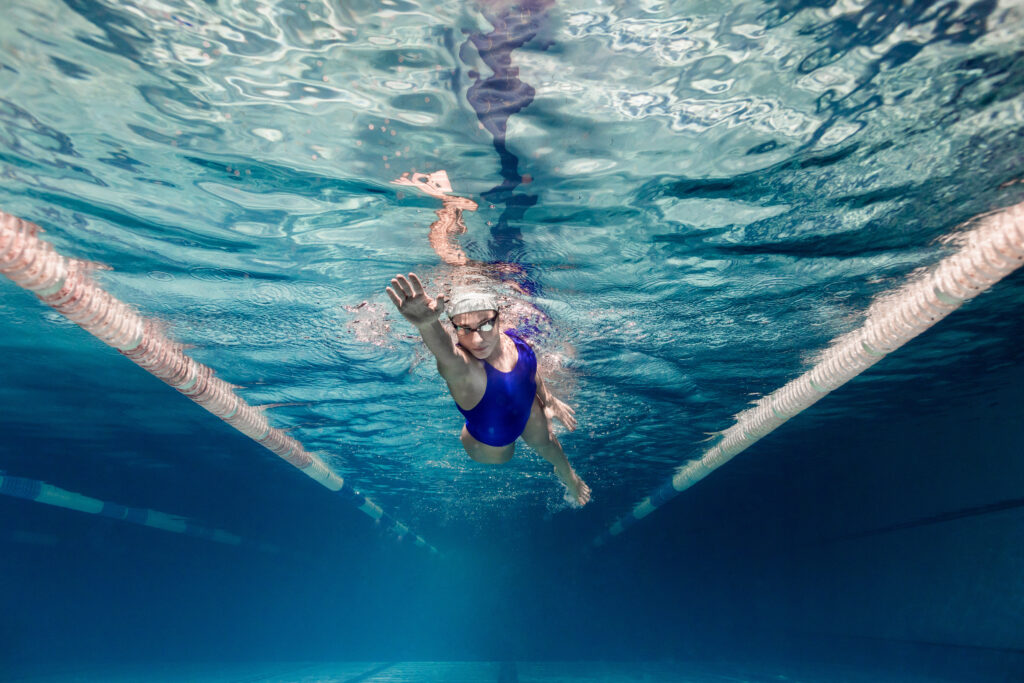January 22, 2024
Why Swim is the Superior Workout
In the vast sea of fitness options, swimming emerges as a refreshing and effective workout that goes beyond the conventional treadmill or weightlifting routine. Dive into the world of aquatic exercise and discover the benefits that make swimming a great choice for achieving and maintaining a healthy lifestyle.
There are many reasons why swimming is a great exercise to incorporate into your fitness routine. Here are three reasons why I believe swimming is the powerhouse of fitness.
#1 – Swimming is a Full-Body Workout:
Swimming stands out as a full-body workout that engages multiple muscle groups simultaneously. From your arms and legs to your core and back, every stroke propels you through the water, providing a comprehensive and balanced exercise routine.
Many people say that swimming is approximately 70% arms and 30% legs, meaning that the strokes—front and back crawl, breaststroke, butterfly, elementary backstroke and sidestroke– all demand powerful arm movements. The continuous resistance of the water challenges your biceps, triceps, and shoulder muscles, promoting strength and definition. The rhythmic motion of reaching and pulling against the water not only builds muscle but also enhances endurance in your upper body.
When it comes to the legs, kicking through the water requires significant leg strength and endurance. Whether you’re executing flutter kicks or the more intricate dolphin kicks, your quadriceps, hamstrings, calves, and glutes are constantly engaged. This not only strengthens the lower body but also improves overall cardiovascular fitness, thereby enhancing your stamina.
Regarding core strength, maintaining a streamlined body position while swimming necessitates a strong and engaged core. The core muscles, including the abdominals, obliques, and lower back, work together to stabilize your body in the water. This continuous activation not only enhances swimming performance but also contributes to a toned and tightened midsection.
In addition to being a full-body exercise, it’s crucial to recognize that swimming takes place in a unique environment compared to typical exercises—specifically, in the water rather than on land. One significant aspect that undergoes a change is our breathing pattern. During land workouts, it is advisable to inhale through the nose and exhale through the mouth. However, in the water, we exhale through the nose while our face is in the water to minimize water entry into the airways and breathe in through the mouth when our airways are above the water surface. Combining correct breathing with every pull and kick will give you the most efficient workout.
#2 – Swimming is a Low-Impact Exercise:
Swimming’s distinction as a low-impact exercise is pivotal for its broad appeal and long-term sustainability. The buoyancy of water significantly reduces stress on joints, making it inclusive for all ages and fitness levels.
Joint-Friendly and Injury-Free: The water’s buoyancy minimizes impact on joints, making swimming ideal for those with arthritis, joint pain, or during rehabilitation. The risk of injury is notably lower compared to high-impact sports, promoting a safe and sustainable workout.
Rehabilitation and Accessibility: Swimming is recommended in rehabilitation plans, leveraging the water’s resistance for gentle yet effective recovery. Its low-impact nature makes it accessible to diverse populations, including older adults and individuals with mobility challenges.
Sustainable Long-Term Fitness: The reduced strain on joints and lower injury risk contribute to the sustainability of swimming as a long-term exercise. It remains viable and enjoyable throughout various life stages, fostering a consistent and enduring fitness routine.
#3 – Swimming can Improve Flexibility and Range of Motion:
Swimming stands out as an incredibly versatile exercise that not only offers cardiovascular benefits but also actively promotes an increased range of motion and enhanced flexibility. The dynamic and fluid movements inherent in swimming engage various muscle groups and joints, encouraging full joint mobility. Whether executing the reaches and pulls in front crawl or incorporating the rotational aspects of back crawl, swimming requires the body to move through a broad range, contributing to improved flexibility in the shoulders, hips, and spine. The resistance of the water adds an extra layer to this dynamic stretching, creating a unique environment that fosters grace and agility in a way that land-based exercises might not achieve.
Beyond the physical benefits, swimming’s promotion of flexibility a lot of holds, especially for rehabilitation purposes. The gentle nature of swimming, coupled with its low-impact characteristics, makes it an excellent choice for individuals recovering from injuries. The varied movements in water allow for controlled and gradual stretching, aiding in the restoration of joint mobility. Whether used as part of a rehabilitation program or incorporated into a regular fitness routine, swimming not only prevents stiffness and joint tightness but also ensures a more adaptable and responsive body.
Overall, swimming isn’t just a sport; it’s a holistic workout that offers a multitude of benefits for both body and mind. Personally, the three reasons highlighted resonate strongly with me, underlining why swimming stands out as the ultimate workout. Swimming, with its full-body engagement, low-impact nature, and flexibility enhancement, also has other benefits, such as its calorie-burning capacity, stress-reducing properties, accessibility for all ages, and cross-training potential. Dive into the pool and experience the joy of movement, the resistance of water, and the transformative impact swimming can have on your overall well-being. Make a splash for a healthier, fitter, and more balanced life!
BACK TO ALL


Comments
There aren't currently any comments on this blog entry.